Lombard Thrust, Southwestern Montana
Overview
The Lombard thrust is one of the major faults of the southern half of the Helena salient of the northern Rocky Mountains, Montana and is part of the east- northeast-striking Southwest Montana Transverse Zone (Harlan et al., 2008). It has a SW-NE convex curved strike from ~46˚ 11' N, where it is broken by the southeast-striking Sixmile Creek fault, to ~45˚ 50' N, where it is inferred to join the east-striking Jefferson Canyon–Cave fault system (see map on fig. 1-1).
It was early recognized and extensively described by Haynes (1916), who was able to date it as Late Cretaceous or Paleocene, since the Cretaceous Kootenai formation is folded while the Oligocene Dunbar formation is undisturbed. Thus the thrust belongs to the Laramide orogeny (Late Cretaceous-Paleocene or Eocene?), which is responsible for the folding and thrusting in the eastern Rocky Mountains and particularly in the Helena salient. The lack of extensive magmatism and the paucity of synorogenic deposits make the dating of the folding difficult. However, Harlan (2005) and Harlan et al. (1988, 2008), using 40Ar/39Ar and paleomagnetic data, were able to precisely date several intrusive sills in the Doherty Mountains, west of Three Forks at 77Ma (Campanian, Late Cretaceous). Since the sills are folded, that indicates that deformation began after 77Ma in that area which lies just north of the Transverse zone.
The Lombard thrust is particularly visible in its northern section, in the Toston-Lombard area, thanks to erosion in the Missouri River canyon, where it dips 40 degrees west (Lorenz and McMurtrey, 1956). Further south it crosses the Hossfeldt Hills, then disappears under the Tertiary sediments of the Three Forks basin, before appearing again in a hilly area southwest of Three Forks.
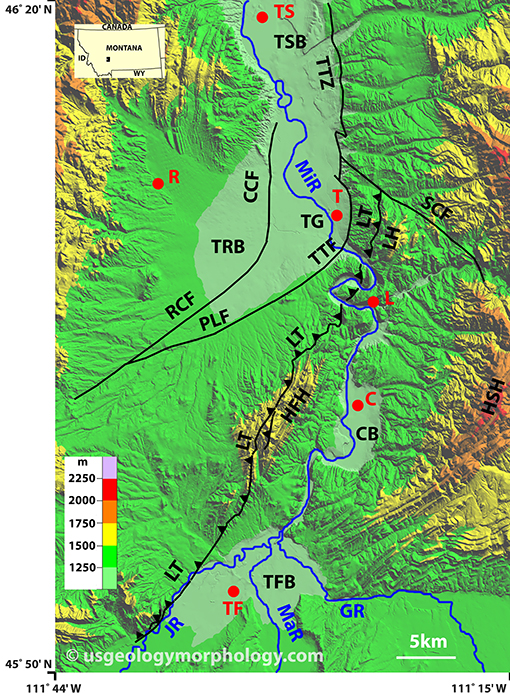
Click on image to enlarge (2MB file)
Figure 1-1. Location map of Lombard thrust and Toston fault, southwestern Montana.
Map of Lombard thrust and Toston fault, southwestern Montana. Inset shows location of map area (black rectangle) in Montana. Only the thrust and faults cited in text are shown. Black lines: faults (certain or inferred). Black line with sawteeth: thrust fault (certain or inferred; sawteeth on overriding plate).
Thrust and faults: CCF - Crow Creek faults (two parallel faults, here generalized); LT - Lombard thrust; PLF - Plunket Lake fault; RCF - Rattlesnake Creek fault; SCF - Sixmile Creek fault; TF - Toston fault; TTZ - Townsend tectonic zone.
Physical features: CB - Clarkston basin; HFH - Hossfeldt Hills; HSH - Horseshoe Hills; LH - Lombard Hills; TFB - Three Forks basin; TG - Toston graben; TRB - Toston-Radersburg basin; TSB - Townsend basin.
Rivers: GR - Gallatin River; JR - Jefferson River; MaR - Madison River; MiR - Missouri River.
Cities and towns: C - Clarkston; L - Lombard; R - Radersburg; T - Toston; TF - Three Forks; TS - Townsend.
Elevation data: USGS. Faults: Robinson (1967), Vuke (2007, 2009), Vuke et al. (2002, 2014).
1 Toston Area
Northern part of the Lombard thrust
The northern entrance of the Missouri River canyon southeast of Toston is where the Lombard thrust is best exposed, as well as several formations from the middle Proterozoic to to the Cretaceous. The middle Proterozoic Greyson shale has been thrusted over the Cretaceous Kootenai formation (siltstone, sandstone and mudstone) and the Jurassic Morrison formation (mudstone, siltstone and sandstone), which lies unconformably on the Jurassic Ellis group (various lithologies). The latter unit lies unconformably on the Permian Phosphoria formation (various lithologies including sandstone and limestone) and the Pennsylvanian Quadrant formation (sandstone and secondary limestone). The unconformities, noticed by Robinson (1967), mean that the older units were tilted and partly eroded before the deposition of the younger units. All the layers show a westward dip and east of the Lombard thrust, erosion has exposed older units eastward.
On the west bank of the Missouri River, and east of the Lombard thrust, a reverse fault moved the Quadrant formation directly over the Jurassic Ellis group, which means that, in this area, the younger Jurassic Morrison and Cretaceous Kootenai formations had been already removed by erosion. Thus this fault is post-Cretaceous or later.
Toston fault
As early as 1925, Pardee discovered several parallel north-striking faults in the eastern side of the Townsend valley, cutting through alluvial terraces (that he called "benches"), notably in the Sixmile Creek lower valley, north of Toston. Haller (2010), using the research of Wong et al. (1999) and of Anderson et al. (2005), completed her database of Quaternary faults in Montana (Haller et al., 2000), called this (these) fault(s) the Toston section of the Canyon Ferry fault, considering this fault as the southern extension of the Canyon Ferry fault (previously recognized by Pardee -1950- and mapped by Witkins -1975-), which approximately parallels the eastern side of Canyon Ferry Lake. Vuke (2009) emphasized the multiplicity of these faults by grouping them under the name of Townsend fault zone; the zone abuts the southeast-striking Sixmile Creek fault at its south. Using aeromagnetic data (Kinoshita et al., 1965) as well as stratigraphic data, Vuke was able to determine that the Townsend fault zone continued south of the Sixmile Creek fault to Toston and beyond southward to join the southwest-striking Plunket Lake fault, itself inferred in the same manner (Vuke, 2007). These three faults (Townsend fault zone, Toston fault and Plunket Lake fault) form a convex arc (see fig. 1-1), more or less parallel to the Lombard thrust, and more generally to the southern half of the Helena salient. Though they are generally thought to be Late Cenozoic (and supposed to be still active), they seem to follow a pattern dating back to the Laramide orogeny.
On the west side of the Radersburg-Toston basin, two largely inferred faults, the Rattlesnake Creek and Crow Creek faults, probably join (Vuke, 2007) to form a similar arc-shaped pattern. In the northern part of the basin, the Crow Creek and Toston faults delineate the Toston graben, inside the larger Radersburg-Toston basin. The graben is now filled with Quaternary deposits.
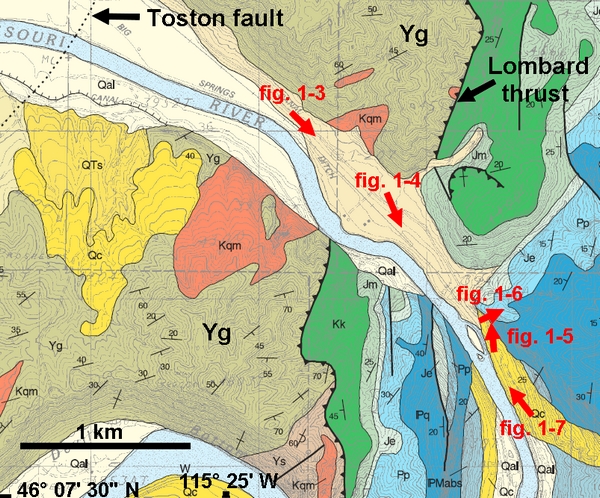
Figure 1-2. Toston area map.
Detailed geologic map showing the location and direction of the following photos. Note that the Toston fault is inferred from geophysical studies. Base map: Vuke (2009).

Figure 1-3. Lombard thrust seen from the northwest.
View to the southeast. Lombard thrust, southeast of Toston, at the northern entrance into the Missouri River canyon. Solid line: thrust trace. Dashed line: thrust dip. Yg: Mesoproterozoic Greyson shale. Jm: Jurassic Morrison formation. Kk: Cretaceous Kootenai formation.

Figure 1-4. A reverse fault or secondary thrust east of the Lombard thrust on the west bank of the Missouri River.
View to the south-southeast. The photo clearly shows the ca. 40-degree dip of the fault to the west. Solid line: thrust with sawteeth on the hanging wall or overriding plate. Dashed lines: unit boundaries. *q: Pennsylvanian Quadrant formation. Pp: Permian Phosphoria formation. Je: Jurassic Ellis group (geologic symbols may not render correctly in some browsers).
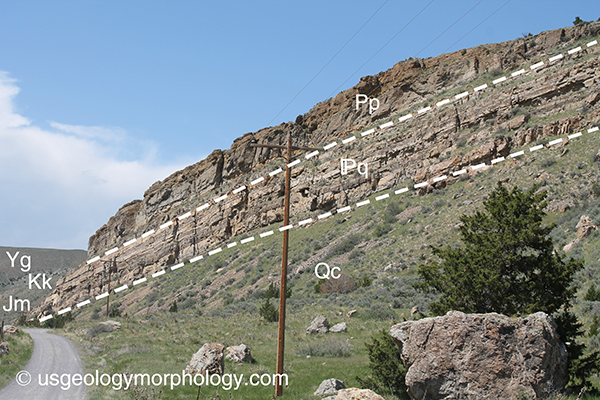
Figure 1-5. East bank of the Missouri River canyon south of the Lombard thrust.
Here, the Cretaceous (Kk) and Jurassic formations have been eroded. Note the western dip of the beds. Qc: Quaternary colluvium. Other symbols as in fig. 1-3 and 1-4.
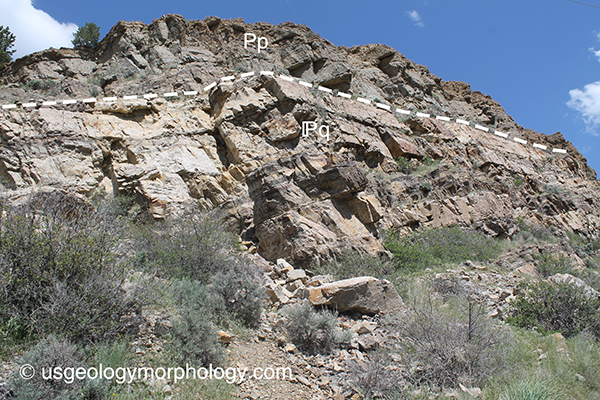
Click on image to enlarge (large file: 3MB)
Figure 1-6. Close-up of the Quadrant and Phosphoria formations on the east bank of the Missouri River canyon.
Same symbols as in fig. 1-4.
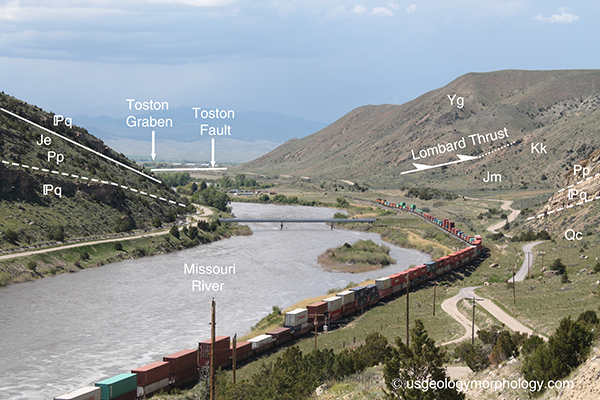
Figure 1-7. General view of the Lombard thrust in the Toston area.
View from the southwest. On the left foreground (west bank), the reverse fault shown in fig. 1-4. On the right foreground the outcrops of the Quadrant and Phosphoria formations shown on fig. 1-5 and 1.6. On the right background, the Lombard thrust, partly concealed by a small valley. In the center background, the Toston fault and the Toston graben. The town of Toston is masked on the right by the Yg hills. Same symbols as in fig. 1-3 and 1-4.
